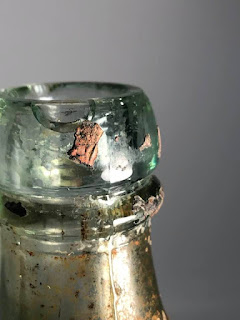Walker's Kilmarnock Whisky and John Lumb & Co.
Not to be confused with Hiram Walker’s Club Whisky of Ontario, Walker’s Kilmarnock (Scotch) Whisky is what we now know as Johnnie Walker’s. Production of Walker’s whisky started in in the 1820s when a young Johnnie Walker started blending his own whiskies in the back of his grocery store, which he started when he was 14 years old after his father died. The company remained in the family until the 1920s.
In the 1860s, the Walker company started using square bottles – they were stronger and more could fit into a case so they were cheaper and easier to ship (because of their proximity to the famous Glasgow and Greenock ports, sailing Captains could act as agents for the company and the brand became popular all over the world after this time). In 1865, the first commercial blend of Walker’s was introduced under the name “Old Highland Whisky”. The “Old Highland Whisky” and “Walker’s Kilmarnock Whisky” names were used until around 1908 when the whisky was re-branded as “Johnnie Walker’s Whisky”. In the case of exports, the bottle likely would have lagged in the market for a couple more years. The bottles found at False Creek would be part of the fill brought to the area before 1913 and would date from before then, fitting with this timeline.
A complete Walker’s Kilmarnock Whiskey bottle was recently recovered from the St. Paul's excavation in False Creek Flats in Vancouver, BC.
Until now, I would have considered this a mould-blown bottle. There are no ghost seams on the bottom or going up the sides, no parison scars on the base, and it looks like it could be mould-blown. But it is not. Along one of the side seams, a very faint ghost seam can be seen on the shoulder and neck (more visible in the first photo below than to the naked eye). And there are mould seams that go around the neck below the string rim, one above the string rim, and a very faint mould seam extending up the finish - something that would not have been noticeable to someone who didn't know what they were looking for.
On one side you can clearly see the ghost seam and primary seam on the neck as well as the seams above and below the string rim.
On the shoulder, you can see the ghost seam following the main seam down (left) and then fading out (right)
On the other side, you can just faintly see the seam extending up onto the finish.
I found a reference in "A Long Stride" - a recently published book on Johnnie Walker's history by Dr. Nicholas Morgan - to Walker's using John Lumb & Co. as their bottle supplier by the "early twentieth century." John Lumb & Co. were one of the first companies in the UK to dedicate their furnaces to the bottle making machine, instead of the manual bottle blower.
As early as 1904 John Lumb & Co. had decided to dispense with mould-blown operations and concentrate on their machine line (Turner 1938:254). Invented in-house, Lumb used the Simpson-Bradshaw semi-automatic machine, which was patented in 1901 (GB patents 21,158; 21,521). They started out with 8 machines, by 1907 they had 23 machines, and by 1914 had 38. In 1913, Walker's loaned Lumb money to acquire patents to fully automate their Simpson-Bradshaw machines.
By 1915, John Lumb & Co. was being taken over completely by Walker’s Whisky (Johnnie Walker’s) (Morgan 2021:125), so now Johnnie Walkers were basically making their own bottles and didn't have to worry about acquisition - an important development given WWI and a new demand for UK-made bottles.
Although Walker’s still makes a relatively inexpensive and very popular scotch, their more expensive labels are quite pricey. Today, a bottle of Johnnie Walker’s Blue Label Whisky can sell for over $300 CAD.







Comments
Post a Comment